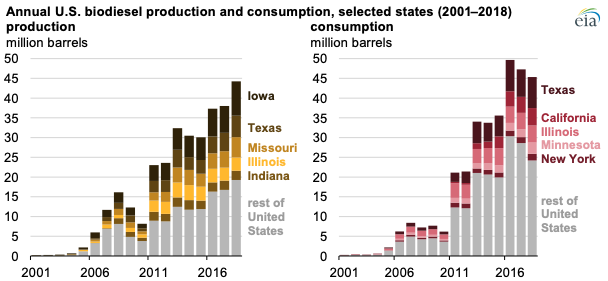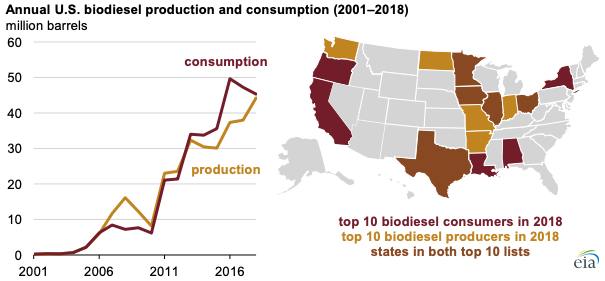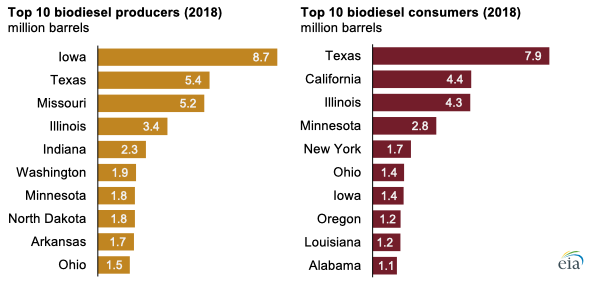The U.S. Energy Information Administration (EIA) recently released new biodiesel estimates in the State Energy Data System (SEDS), EIA’s comprehensive source for annual state energy statistics. Previously, EIA published national-level biodiesel data as well as state- and plant-level biodiesel plant production capacity. New SEDS estimates include annual biodiesel production and consumption data by state for 2001 through 2018.

Biodiesel is a liquid biofuel used as an additive or substitute for petroleum-based diesel fuel in vehicles, and it is typically made from vegetable oils—such as soybean, corn, and canola oil—animal fats, or recycled restaurant grease feedstocks. It does not include renewable diesel, which is processed differently in order to create a fuel that is chemically identical to petroleum-based diesel. Biodiesel produces fewer air pollutants than petroleum diesel fuel and can benefit engines by providing additional lubrication and increasing performance. A common blend of diesel and biodiesel fuel sold at the pump is B20, which is 20% biodiesel. SEDS data reflect an assumption that all biodiesel is used in the transportation sector, although it can also be used as heating oil and for electricity generation.

U.S. biodiesel production and consumption have increased substantially since 2001. However, U.S. biodiesel production decreased by 49% from 2008 to 2010 as a result of a number of factors. These factors include overproduction in earlier years, European trade policies, and reduced overall demand for transportation fuels driven by the 2008–2009 global recession. However, production has since increased, despite biodiesel tax credits that expired in 2016. Since 2016, U.S. biodiesel production has increased significantly to meet domestic demand and to offset lower biodiesel imports. In 2018, the United States produced 44 million barrels and consumed 45 million barrels of biodiesel.
Iowa, a top corn and soybean producer, has been the state with the most biodiesel production in the nation every year on record since 2001. A total of 8.7 million barrels (or 365 million gallons) of biodiesel was produced in Iowa in 2018, or 20% of U.S. total biodiesel production. Iowa has the largest biodiesel plant production capacity in the nation at nearly 10.6 million barrels (445 million gallons) per year in 2019, about 17% of the nation’s total capacity. Texas has been the second-largest producing state for biodiesel since 2016, when it surpassed Illinois and Missouri. The Port Neches biodiesel plant near Beaumont, Texas, has the largest production capacity in the nation at 178 million gallons per year.

Texas has had the most biodiesel consumption of any state since 2013, and it consumed nearly 8 million barrels in 2018, about 17% of the nation’s total. Texas has the most distillate fuel oil (diesel) consumption of any state by a wide margin and has the second-most vehicle miles traveled in the nation after California. Texas also requires alternative vehicle use in government fleets and offers a number of biodiesel-related incentives. California, which has many biodiesel-related laws and incentives, surpassed Illinois with the second-most biodiesel consumption in 2018.
Principal contributor: Mickey Francis

Follow us on social media: